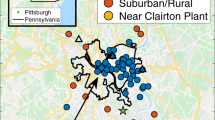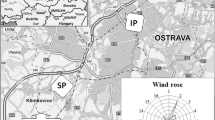Abstract
Urban air pollution has become an inescapable issue due to its serious consequences on public health and, therefore, needs more accurate tracking through denser networks of air quality monitoring (AQM) stations. A higher density of these networks can be afforded by cities only if the costs of future individual AQM stations decrease. We review here the outcome of two European projects where our objective was to provide an alternative approach consisting in the development of cost-effective mobile microstations based on semiconductor sensors and capable of complementing the expensive and bulky current AQM stations. Improvement of the sensor sensitivity to detect very low levels of pollutants (CO, NO, NO2, O3) in air was the major challenge to take up. This was achieved by using metal oxide nanosized particles with both controlled size and surface chemistry, and by adapting the screen-printing process to the nanometer size specificity. The detection thresholds for NO2, NO and O3 of our nanoparticles-based sensors have been decreased by a factor of 3–5 compared to currently commercialized sensors. The lowest detectable concentration of CO has been reduced from 5 to 3 ppm without affecting the selectivity. In terms of sensitivity performance, our sensor prototypes can now meet the criteria for outdoor AQM whereas the commercial semiconductor and electrochemical sensors still cannot. As for the implementation of the network as a whole, our technological approach is outlined.
Similar content being viewed by others
References
Baraton M.-I., 1999. In: Nalwa H.S. ed. Handbook of Nanostructured Materials and Nanotechnology; FT-IR Surface Spectrometry of Nanosized Particles. Academic Press, San Diego, pp. 89-153.
Baraton M.-I., 2000. In: Chow G.-M., Ovid'ko I.A. and Tsakalakos T. eds. Nanostructured Films and Coatings; Surface Characterization of Nanostructured Coatings: Study of Nanocrystalline SnO2 Gas Sensors, NATO-ARW Series, Kluwer Academic Publishers, Dordrecht, pp. 187-201.
Baraton M.-I., 2002. In: Knauth P. and Schoonman J. eds. Nanocrystalline Metals and Oxides: Selected Properties and Applications; Surface Analysis of Semiconducting Nanoparti-cles by FTIR Spectroscopy: Application to the Evaluation of Gas Sensing Properties. Kluwer Academic Publishers, Boston, pp. 165-187.
Baraton M.-I. & L. Merhari, 1998. Surface properties control of semiconducting metal oxides nanoparticles. NanoStruct. Mater. 10, 699-713.
Baraton M.-I. & L. Merhari, 2000. In: Komarneni S., Parker J.C. and Hahn H. eds. Nanophase and Nanocomposite Materials III; Chemical Reactions on the Surface of SnO2 Nanosized Powders at the Origin of the Gas Sensing Properties: FTIR Investigation, MRS Symposium Proceeding Series Vol. 581. MRS Publisher, Warrendale, pp. 559-564.
Baraton M.-I. & L. Merhari, 2001a. Influence of the particle size on the surface reactivity and gas sensing properties of SnO2 nanopowders. Mater. Trans. 42, 1616-1622.
Baraton M.-I. & L. Merhari, 2001b. Determination of the gas sens-ing potentiality of nanosized powders by FTIR spectrometry. Scripta Mater. 44, 1643-1648.
Baraton M.-I., L. Merhari, H. Ferkel & J.F. Castagnet, 2002. Comparison of the gas sensing properties of tin, indium and tungsten oxides nanopowders: Carbon monoxide detection and humidity effects. Mater. Sci. Eng. C 19, 315-321.
Chabal Y.J., 1988. Surface infrared spectroscopy. Surf. Sci. Rep. 8, 211-357.
Chancel F., J. Tribout & M.-I. Baraton, 1998. In: Gonsalves K.E, Baraton M.-I. et al. eds. Surface Controlled Nanoscale Materials for High-Added-Value Applications; Effect of Sur-face Modification on the Electrical Properties of TiO2 and SnO2 Nanopowders, MRS Symposium Proceeding Series Vol. 501. MRS Publisher, Warrendale, pp. 89-94.
Clifford P.K., 1981. Mechanisms of Gas Detection by Metal Oxide Surfaces. Ph.D. Thesis, Carnegie Mellon University, Pittsburg.
Cox D.F, T.B. Fryberger & S. Semancik, 1988. Oxygen vacancies and defect electronic states on the SnO2(110)-1 ×1 surface. Phys. Rev. B 38, 2072-2083.
Emiroglu S., N. B. arsan, U. Weimar & V. Hoffmann, 2001. In situ diffuse reflectance infrared spectroscopy study of CO adsorp-tion on SnO2. Thin Solid Films 391, 176-185.
Gibson A.F., 1958. Infrared and microwave modulation using free carriers in semiconductors. J. Sci. Instrum. 35, 273-278.
Harrick N.J., 1962. Optical spectrum of the semiconductor sur-face states from frustrated total internal reflection. Phys. Rev. 125, 1165-1170.
Harrick N.J., 1967. Internal Reflection Spectroscopy. Interscience, Wiley, New York.
Harrison P.G. & B.M. Maunders, 1984. Tin oxide surfaces. Part 12. A comparison of the nature of tin(IV) oxide, tin(IV) oxide-silica and tin (IV) oxide-palladium oxide: Surface hydroxyl groups and ammonia adsorption. J. Chem. Soc. Faraday Trans. I 80, 1341-1356.
Henrich V.E. & P.A. Cox, 1994. The Surface Science of Metal Oxides. Cambridge University Press, Cambridge.
INTAIRNET Second Year Report (contract No. IST-1999-12615), 2002. Unpublished results.
Morrison R.S., 1994. In: Sze S.M. ed. Semiconductor Sensors; Chemical Sensors, Chapter 8. John Wiley & Sons, New York, pp. 383-413.
Oca"na M. & C.J. Serna, 1991. Variations of the infrared pow-der spectra of TiO2 and SnO2 (rutile) with polarization. Spectrochim. Acta 47A, 765-774.
Oca"na M., C.J. Serna, J.V. Garcia-Ramos & E. Matijeviæ, 1993. A vibrational study of uniform SnO2 powders of various morphologies. Solid State Ionics 63-65, 170-177.
Ogawa H., M. Nishikawa & A. Abe, 1982. Hall measurement studies and an electrical conduction model of tin oxide ultrafine particle films. J. Appl. Phys. 53, 4448-4455.
Panchapakesan B., D.L. DeVoe, M.R. Widmaier, R. Cavicchi & S. Semancik, 2001. Nanoparticle engineering and control of tin oxide microstructures for chemical microsensor applications. Nanotechnology 12, 336-349.
Riehemann W., 1998. In: Gonsalves K.E, Baraton M.-I. et al. eds. Surface Controlled Nanoscale Materials for High-Added-Value Applications; Synthesis of Nanoscaled Powders by Laser-Evaporation of Materials, MRS Symposium Proceeding Series Vol. 501. MRS Publisher, Warrendale, pp. 3-14.
Shimizu Y. & M. Egashira, 1999. Basic aspects and challenges of semiconductor gas sensors. MRS Bull. 24, 18-24.
SMOGLESS Final Report (contract No.: BRPR-CT95-0002), 1999. Unpublished results.
Somorjai G.A., 1994. Introduction to Surface Chemistry and Catalysis. John Wiley & Sons, New York.
Thornton E.W. & P.G. Harrison, 1975. Tin oxide surfaces. Part 1. Surface hydroxyl groups and the chemisorption of carbon dioxide and carbon monoxide on tin(IV) oxide. J. Chem. Soc. Faraday Trans. 1 71, 461-73.
Tribout J., F. Chancel, M.-I. Baraton, H. Ferkel & W. Riehemann, 1998. In: Gonsalves K.E, Baraton M.-I. et al. eds. Surface Controlled Nanoscale Materials for High-Added-Value Applications; Oxygen Adsorption on Tin Oxide Nanosized Powders Characterized by FT-IR Spectrometry and Relation with the Sensor Properties, MRS Symposium Proceeding Series Vol. 501. MRS Publisher, Warrendale, pp. 95-100.
Willett M.J., V.N. Burganos, C.D. Tsakiroglou & A.C. Payatakes, 1998. Gas sensing and structural properties of variously pretreated nanopowder tin (IV) oxide samples. Sens. Actuators B53, 76-90.
Williams G. & G.S.V. Coles, 1998. Gas sensing properties of nanocrystalline metal oxide powders produced by a laser evaporation technique. J. Mater. Chem. 8, 1657-1664.
Williams G. & G.S.V. Coles, 1999. The gassensing potential of nanocrystalline tin dioxide produced by a laser ablation technique. MRS Bull. 24, 25-29.
Author information
Authors and Affiliations
Rights and permissions
About this article
Cite this article
Baraton, MI., Merhari, L. Advances in Air Quality Monitoring via Nanotechnology. Journal of Nanoparticle Research 6, 107–117 (2004). https://doi.org/10.1023/B:NANO.0000023239.56676.12
Issue Date:
DOI: https://doi.org/10.1023/B:NANO.0000023239.56676.12




